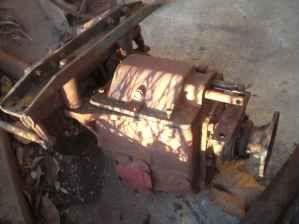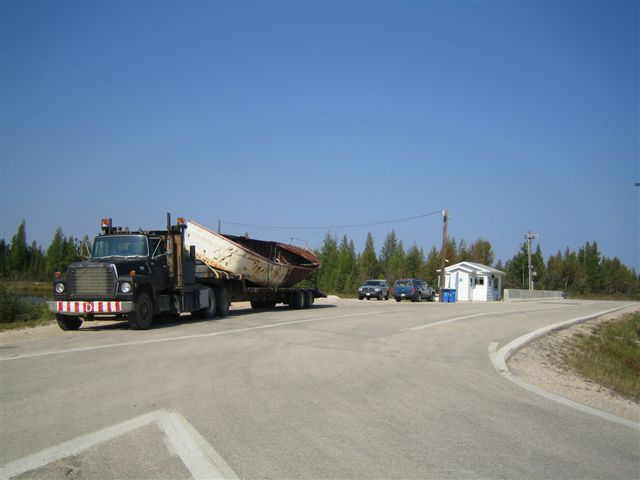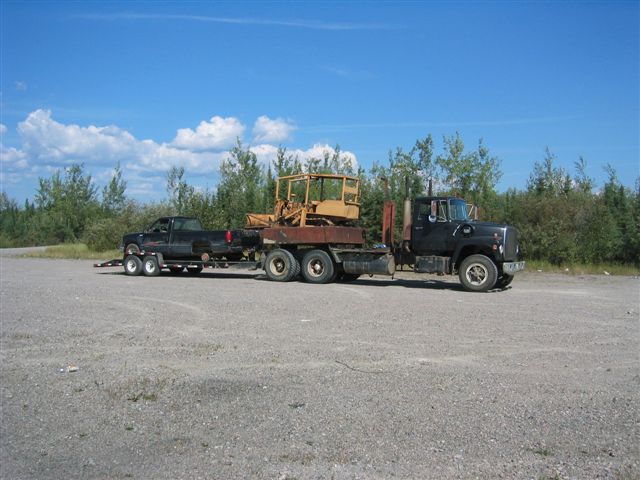-
Posts
86 -
Joined
-
Last visited
Content Type
Profiles
Forums
Gallery
Events
Blogs
BMT Wiki
Collections
Store
Posts posted by Joe Cummings
-
-
What is it you expect out of this truck? Will it ever haul anything? are you just going to drive it to get to shows?
I take it that the truck has 10;00x20 rubber on it?
Why get rid of the 401? It is a very valid piece of history. I know I enjoy seeing gas motored class 8 trucks at the show.
Why not put another 401 in it, and put a 3 speed brownie behind the quad box so you can travel at highway speeds to get to shows or events?

-
A good thing to remember for repairing/designing frame rails, or bridge beams is,,,,,,,
Avoid abrupt change in section, in areas of high moment
BTW 45LMSWM, I was bidding on your truck at a Vilsmeir auction down in South Jersey back in like 86, It looked pretty good but it was sitting front axle on the ground. Someone had taken the steering rubber off of it
-
You are looking at a lot of work. If you are going to go diesel you are going to have to add radiation area, and forget the quad box you have. The later model 92 and 93 carriers will go into your rear axles, but you can't get the all the bolts in. Although I have run working trucks with the late model carriers in the early axles without a problem.
-
Not much to that Zenith carb really. Is the throttle shaft still tight?
-
Yeah, I am impressed with the metalworking skills. Me and sheet metal really don't get along well lol. I can straighten a 36" beam easier than I can work with tin.
-
-



Just a typical day of going out to lift something
-
Thanks for the file. I was looking for my copy to scan and upload, but not sure where it is lol. I was thinking they dropped it from the somewhat newer (in the ring binders) manual
-
You guys that can't fix a frame rail are funny.
It used to be that replacing one side frame rail on a single frame tractor was about a 40 man hour project for a good man.
Add to that a double frame, lift axle, and dump body, and you are probably talking 60 + man hours worth of work if nothing else goes wrong. at $100 @ hour and after you add in all the hardware and consumables, plus 3,500 for the frame rails. Well that 11 G number sounds about right. plus you are going to probably lose the truck for a couple of weeks, so add another 5 or 10 g to that number in lost revenue.
Suddenly a couple of grand and 2 days downtime is starting to look like a good idea
The guy isn't doing a restoration, he's fixing a working truck.
-
You in the whitness protection program or sumptin?
And that's the hardest part. Today everything is different; there's no action... have to wait around like everyone else. Can't even get decent food - right after I got here, I ordered some spaghetti with marinara sauce, and I got egg noodles and ketchup. I'm an average nobody... get to live the rest of my life like a schnook.
Henry Hill Goodfellas
-
I have no doubt that I personally can fix frame rails, I've done it many times in the past and never had a problem. Please don't pass judgement on my abilities without knowing anything about me. I'm just trying to help the guy by sending him to someone that can handle it.
I have no personal interest in the job, I'm busy as hell with bridge repairs right now.
I'm sure Eugene could care less if the guy comes to his shop or not. A couple thousand dollar frame repair isn't going to make or break him either.
BTW, If you find yourself a Mack repair manual from the 60's or 70's (the old manual that was a single bound volume) there is a guide in the front about how to properly repair truck frame rails. Follow what the guide says and it won't break.
-
Looking for this # 81551 piston for an air-o-matic steering cylinder. I really just need the piston, but this is on a working piece of equipment that has to be on a bridge job on the 1st. So if someone knows were to buy a new piston, or even a whole new cylinder, please let me know.
Here are all the numbers stamped into the cylinder
85012
C12314
thanks
-
You bolt fishplates in using "body bond" bolts, or else huck bolts. The body bound bolts are actually a press fit in both the frame rail and in the fish plate.
I can hook you up with a guy who can fix those rails. His name is Eugene Evans and he is in philly near ontairio and richmond.
My number is on my website www.cummingshauling.com Best way to catch me is to call the 201 number. I'll hook you up with his number.
BTW, Where's Ketter? I know he can fix frame rails too, but he is far far away in the land of lousy pizza lmao
-
This is the VOLVO D13 engine.

This is the VOLVO D11 Engine.

This is the VOLVO D16 Engine.. (What soon will be cloned as the MACK MP10)

This is the MACK MP7 engine.

Are they the same ???? or Do they share external components that makes them look alike ??????
Please read this.
All in the Family
Mack and Volvo engines may come out of one factory, but they aren't twins
By Paul Abelson
Mack and Volvo engines for 2007 have much in common, both with other 2007 engine brands and with each other. As with most other engine makers’ offerings, this includes cooled exhaust gas recirculation (EGR) to control oxides of nitrogen (NOx), diesel particulate filters (DPF) to control soot and particulate matter (PM) and variable geometry turbochargers (VGT) that control throttle response and improve drivability.
But commonality does not mean that these engines are identical. All diesel engines use compression ignition and will burn the same ultra low sulfur diesel (ULSD), but they differ in many important details. Mack and Volvo strategies for meeting 2007 (and 2010) EPA emissions regulations are similar to others’ but differ in detail.
Mack and Volvo are mentioned together because they are sister companies, part of Sweden’s AB Volvo. Both makes’ engines are made at the Volvo Powertrain Hagerstown, Md., factory. The engines are similar, but they differ according to the particular market they’re developed for, and the nature of the truck they go into.
Both makes share the same production lines. Engine blocks and cylinder heads are identical. Both use an overhead cam design with four valves per cylinder. They have 38 cylinder head fasteners to better contain increased pressures in the cylinders and the fuel injection system. Both use steel ladder-type reinforcement that increases stiffness at the main bearings for greater resistance to distortion.
The common design has internal drive gears that turn the camshaft, air compressor and power steering pump. The camshaft has a viscous vibration damper. Placing the damper there helps absorb torsional vibrations created by the high-pressure fuel injection system, and directs them to the flywheel where they are managed with traditional hardware.
The engines come in three sizes, roughly 700 cu-in, 800 cu-in and 1,000 cu-in. In Volvo nomenclature, based on liters of displacement, they are the D11, D13 and D16. Mack’s system designates hundreds of cubic inches: MP7, MP8 and, for later release, MP10.
A sliding nozzle controls the variability feature of the VGTs, allowing the turbochargers to respond virtually instantly to throttle demands and engine requirements. Drivers of pre-10/02 engines are amazed at the responsiveness and lack of turbo lag of VGT-equipped engines.
Mack Specifics
Mack’s fourth generation Vehicle Management and Control System, V-MAC IV, allows tailoring of the engines for specific customer applications. For LTL operations primarily on Interstate highways and application where fuel economy is the top priority, Econodyne engines have an operating range from 1200 to 1800 rpm. MaxiCruise engines are for full-load applications and travel on rolling Interstates. Its rpm range is 1200 to 1950. For applications requiring highest power — off-highway, mountains and other severe-duty applications — Maxidyne engines run from 1200 up to 2100 rpm.
For 2007, MP7 engines will offer from 325 hp to 405 hp. Torque will range from 1260 to 1560 lb-ft. Thirteen-liter MP8 engines will be available starting in 2007. Power will be 415 hp to 485 hp, with torque of 1540 lb-ft to 1700 lb-ft. MP8s will be available for all three applications. Details of MP10 engines have not yet been announced. For Mack buyers needing big power, Cummins ISX engines are available.
The V-MAC IV system allows Mack to program customer-requested variables including idle shutdown, improved theft deterrence, tamper detection and normal operating parameters.
Mack’s proprietary PowerLeash engine brake is light-weight. The company claims best-in-class braking performance.
Volvo Features
The Volvo engine lineup for 2007 is based on vocation and the Volvo trucks that they will power. The 11-liter D11 is intended for P&D, LTL and regional distribution, in VNM (medium hood) and VNL (long hood) truck models. Horsepower will range form 325 to 405. Torque will be 1250 lb-ft to 1450 lb-ft. The D13, derived from the D12, which will no longer be available, is for economical line haul and long haul, as well as general vocational applications. The D13 will go into VNM, VNL and VHD trucks and tractors. Horsepower availability is from 335 to 485, with 1350 lb-ft to 1650 lb-ft of torque.
Volvo’s “big power†is the D16, developed to meet 2007 and 2010 regulations. While early D16s had as much as 625 hp and 2250 lb-ft, 2007 models will start at 450 hp and to “only†600 hp. Its torque goes from 1650 lb-ft to 2050 lb-ft. The big engine is intended for heavy haul and over-the-mountains Interstate travel. It will be available only in Volvo VNL and VT (premium sleeper) trucks and tractors.
The Volvo Engine Brake (VEB) is a two-part system, consisting of a compression brake and an exhaust pressure governor. The combination allows more effective braking at lower engine speed, especially below 1600 rpm. The engine brake weighs only 25 lbs. The VEB is so quiet, it can be used in communities where use of compression brakes is restricted.
The exhaust pressure governor works with the compression brake. It restricts the exhaust to build backpressure when the parking brake is on and coolant temperature is below 149 degrees F. That places a load on the engine, which raises engine temperature until temperature reaches 158 degrees F. It provides more rapid warm-up after engine start. The unit saves fuel by keeping warm air in the cylinder, allowing idling as low as 500 rpm.
See this article at:
Paul Abelson is pretty much an idiot. I think he is as full of it as that guy from Pittsburgh power.
-
I would make sure I had heavy enough cables on it. Low voltage will burn up starters. What starter is on it? A delco 40-MT? If so I think the next heavier one is the 50-MT. I'm pretty sure you can get the right nose and drive gear for it to bolt up.
-
Do you think he is talking about a TRT? I forget how many gears I could get out of them dot counting real close ones and duplicates.
-
I was always taught to grease and adjust brakes once a week. When I was a kid that was what I did every Saturday morning. I can't imagine letting them go 5 K between greasing. I get a kick out of it when I see fleet mechanics standing around. When I ask why, they say nothing needs to be done. Maybe it's just me, but I was taught by a tough old timer. You never stand around, you grab any piece of equipment in the yard, grease it, adjust the brakes, check the lights, look for air leaks, check that no hoses are rubbing, and,,,,,,,,,,,,, so on and so on,,,,,,,,,,,,,,,,,
-
You know I miss opening a hood and seeing that old 2 valve 237. It was probably the best engine ever made. And the easiest to work on.
-


Rob, here is a Brockway with one
-
That engine looks like a 2 valve to me. Are you sure it's an 1988?
-
All the C engines I have worked on had fire ring liners in them. That's not to say they were all built that way originaly. The fire ring liners and gaskets could be used with any 672 inch block with 20 stud heads, as long as you cut the heads for them. In fact I was told that you could use the fire rings in an 18 stud engine if you cut the gasket, but I have never confirmed this.
As far as the clutch being a pull type in all Maxidynes. I had both a 68 R600 and a 69 DM600 both original Maxidyne trucks that had push type clutches in them. I think they were called CL-50. they had a 2" spline and the trans was somewhat different. The clutch brake wasn't on the spline, it was on the bottom countershaft as I remember.
-
Cat in a Mack??? Excuse me while I puke
-
I always wanted to buy a brand new mack and spec it just the way I wanted it. Now that I have the money, they pretty much don't make a Mack any more.
You would think that the people at Mack would know, what we want is an RD with a dry sleeve Maxidyne engine in about the 400HP range, Some kind of inline fuel pump like an American Bosch APE series, not that E-tech junk, Some kind of trans like a TRXL107 or TRXXL107 but capable of handling about 2000 FP of torque, And 44.000 or 55,000 Camelback suspention on bronze bushings 92, 93 or 112, 113 carriers.
I know you have to make it all electronic, but please make the harness a little heavier, and make some plugs and connectors that will stand up to severe service.
Seeing what Volvo has done to Mack, makes me want to bang my head against the wall too.
-
I was thinking for an antique truck, if the 220 is in good shape, why not just change the button? Probably get it to pump out 300HP without a problem. A button only costs about 10 bucks.







J'ever Work Your A** Off And Gain Nuthin?
in Antique and Classic Mack Trucks General Discussion
Posted
Damn why don't you old fellers buy yourself forklifts. Once you have one you'll wonder how you ever lived without one
Although after a while you can kinda go forklift nuts, I'm up to 5 now lol